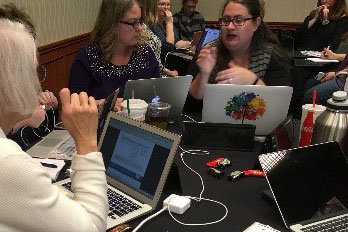Just a few weeks before the start of school, 13 early childhood teachers and staff from the Hallsville R-IV and Glenwood R-8 School Districts in Missouri, including Superintendents John Downs and Wayne Stewart, gathered to discuss the research on quality indicators for prekindergarten (PK) classrooms.
The Hallsville school district has plans to open its first PK classroom with the passage of Missouri House Bill 1689 that allows for the funding of PK students who qualify for free and reduced lunch. Anticipating the opening of this classroom, Hallsville Superintendent Downs turned to REL Central for information on research-based indicators of PK quality. Glenwood school district on the other hand currently implements a PK classroom, however Superintendent Stewart also sought information on PK quality indicators to improve the readiness of incoming kindergarteners.

Research shows that high-quality early care and education programs can have lasting positive effects, including greater school success, higher graduation rates, lower juvenile crime, and lower adolescent pregnancy rates (Friedman & Amadeo, 1999; Halle, Whittaker Vick, & Anderson, 2010; Smolensky & Gootman, 2003). Moreover, these effects are magnified for children from at-risk backgrounds or those with special needs, who are least likely to have access to quality early care and education. Research examining program quality and child outcomes commonly defines quality in terms of structure or process indicators:
- Structural quality includes features of the environment–for example, group size, ratio, and staff qualifications–that can increase the likelihood of positive process quality. Structural quality indicators are often easily regulated.
- Process quality involves interactions with children and structuring of the environment so that care is emotionally responsive, stimulating, and safe.
REL Central and the Hallsville and Glenwood partners met for a full-day training on indicators of PK quality. During the training, REL Central presented research-based information on the implementation and measurement of PK quality indicators that aligned with the Early Learning Program Guidance by the Missouri Department of Elementary and Secondary Education. REL Central gathered the information from the literature and resources such as the What Works Clearinghouse, the ERIC database, search engines, and national early childhood organizations.
Throughout the training, Hallsville and Glenwood partners engaged in small- and whole-group discussions regarding the implementation of the research-based PK quality indicators presented by REL Central, both within and across their particular district contexts. These discussions focused on clarifying each PK quality indicator, exploring how to address each indicator, implementing strategies within indicators, and identifying implementation roadblocks and ways to overcome them to provide the partners with a foundation of research-based elements and strategies to support a high-quality PK classroom.
At the end of the training, REL Central engaged Glenwood and Hallsville partners in a discussion about the feasibility of implementation of the strategies presented. Staff, including teachers and curriculum directors, from each district identified strategies and practices that they will implement in classrooms this year.
Superintendent Stewart was excited for his staff to attend the training and gain new resources on implementing quality indicators in the district’s PK classroom. “My new curriculum director and teachers will be putting this new knowledge and methods into action on day one!”
References
Friedman, S. L., & Amadeo, J.-A. (1999).
The child-care environment: Conceptualizations, assessments, and issues. In S. L. Friedman & T. D. Wachs (Eds.),
Measuring environment across the life span: Emerging methods and concepts (pp. 127–165).
Washington, DC: American Psychological Association.
Halle, T., Vick Whittaker, J., & Anderson, R. (2010).
Quality in early childhood care and education settings: A compendium of measures (2nd ed.).
Washington, DC: U.S. Department of Health and Human Services, Administration for Children and Families, Office of Planning, Research and Evaluation.
Retrieved from https://www.acf.hhs.gov/opre/resource/quality-in-early-childhood-care-and-education-settings-a-compendium-of
Smolensky, E., & Gootman, J. A. (Eds.). (2003).
Working families and growing kids: Caring for children and adolescents.
Washington, DC: National Academies Press.





